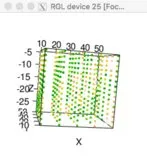有没有一个R包可以进行X、Y、Z、V插值?我看到Akima可以进行X、Y、V插值,但我需要更多的维度。
基本上,我有X、Y、Z坐标加上我想要插值的值(V)。这都是GIS数据,但我的GIS不做体元插值。
所以,如果我有一个XYZ坐标的点云,其值为V,如何插值出在XYZ坐标(15,15,-12)处的V值?一些测试数据可能如下:
X <-rbind(10,10,10,10,10,10,10,10,10,10,10,10,10,10,10,10,10,10,10,10,10,10,10,10,10,20,20,20,20,20,20,20,20,20,20,20,20,20,20,20,20,20,20,20,20,20,20,20,20,20,30,30,30,30,30,30,30,30,30,30,30,30,30,30,30,30,30,30,30,30,30,30,30,30,30,40,40,40,40,40,40,40,40,40,40,40,40,40,40,40,40,40,40,40,40,40,40,40,40,40,50,50,50,50,50,50,50,50,50,50,50,50,50,50,50,50,50,50,50,50,50,50,50,50,50,10,10,10,10,10,10,10,10,10,10,10,10,10,10,10,10,10,10,10,10,10,10,10,10,10,20,20,20,20,20,20,20,20,20,20,20,20,20,20,20,20,20,20,20,20,20,20,20,20,20,30,30,30,30,30,30,30,30,30,30,30,30,30,30,30,30,30,30,30,30,30,30,30,30,30,40,40,40,40,40,40,40,40,40,40,40,40,40,40,40,40,40,40,40,40,40,40,40,40,40,50,50,50,50,50,50,50,50,50,50,50,50,50,50,50,50,50,50,50,50,50,50,50,50,50,10,10,10,10,10,10,10,10,10,10,10,10,10,10,10,10,10,10,10,10,10,10,10,10,10,20,20,20,20,20,20,20,20,20,20,20,20,20,20,20,20,20,20,20,20,20,20,20,20,20,30,30,30,30,30,30,30,30,30,30,30,30,30,30,30,30,30,30,30,30,30,30,30,30,30,40,40,40,40,40,40,40,40,40,40,40,40,40,40,40,40,40,40,40,40,40,40,40,40,40,50,50,50,50,50,50,50,50,50,50,50,50,50,50,50,50,50,50,50,50,50,50,50,50,50)
Y <- rbind(10,10,10,10,10,20,20,20,20,20,30,30,30,30,30,40,40,40,40,40,50,50,50,50,50,10,10,10,10,10,20,20,20,20,20,30,30,30,30,30,40,40,40,40,40,50,50,50,50,50,10,10,10,10,10,20,20,20,20,20,30,30,30,30,30,40,40,40,40,40,50,50,50,50,50,10,10,10,10,10,20,20,20,20,20,30,30,30,30,30,40,40,40,40,40,50,50,50,50,50,10,10,10,10,10,20,20,20,20,20,30,30,30,30,30,40,40,40,40,40,50,50,50,50,50,10,10,10,10,10,20,20,20,20,20,30,30,30,30,30,40,40,40,40,40,50,50,50,50,50,10,10,10,10,10,20,20,20,20,20,30,30,30,30,30,40,40,40,40,40,50,50,50,50,50,10,10,10,10,10,20,20,20,20,20,30,30,30,30,30,40,40,40,40,40,50,50,50,50,50,10,10,10,10,10,20,20,20,20,20,30,30,30,30,30,40,40,40,40,40,50,50,50,50,50,10,10,10,10,10,20,20,20,20,20,30,30,30,30,30,40,40,40,40,40,50,50,50,50,50,10,10,10,10,10,20,20,20,20,20,30,30,30,30,30,40,40,40,40,40,50,50,50,50,50,10,10,10,10,10,20,20,20,20,20,30,30,30,30,30,40,40,40,40,40,50,50,50,50,50,10,10,10,10,10,20,20,20,20,20,30,30,30,30,30,40,40,40,40,40,50,50,50,50,50,10,10,10,10,10,20,20,20,20,20,30,30,30,30,30,40,40,40,40,40,50,50,50,50,50,10,10,10,10,10,20,20,20,20,20,30,30,30,30,30,40,40,40,40,40,50,50,50,50,50)
Z <- rbind(-5,-5,-5,-5,-5,-5,-5,-5,-5,-5,-5,-5,-5,-5,-5,-5,-5,-5,-5,-5,-5,-5,-5,-5,-5,-5,-5,-5,-5,-5,-5,-5,-5,-5,-5,-5,-5,-5,-5,-5,-5,-5,-5,-5,-5,-5,-5,-5,-5,-5,-5,-5,-5,-5,-5,-5,-5,-5,-5,-5,-5,-5,-5,-5,-5,-5,-5,-5,-5,-5,-5,-5,-5,-5,-5,-5,-5,-5,-5,-5,-5,-5,-5,-5,-5,-5,-5,-5,-5,-5,-5,-5,-5,-5,-5,-5,-5,-5,-5,-5,-5,-5,-5,-5,-5,-5,-5,-5,-5,-5,-5,-5,-5,-5,-5,-5,-5,-5,-5,-5,-5,-5,-5,-5,-5,-17,-17,-17,-17,-17,-17,-17,-17,-17,-17,-17,-17,-17,-17,-17,-17,-17,-17,-17,-17,-17,-17,-17,-17,-17,-17,-17,-17,-17,-17,-17,-17,-17,-17,-17,-17,-17,-17,-17,-17,-17,-17,-17,-17,-17,-17,-17,-17,-17,-17,-17,-17,-17,-17,-17,-17,-17,-17,-17,-17,-17,-17,-17,-17,-17,-17,-17,-17,-17,-17,-17,-17,-17,-17,-17,-17,-17,-17,-17,-17,-17,-17,-17,-17,-17,-17,-17,-17,-17,-17,-17,-17,-17,-17,-17,-17,-17,-17,-17,-17,-17,-17,-17,-17,-17,-17,-17,-17,-17,-17,-17,-17,-17,-17,-17,-17,-17,-17,-17,-17,-17,-17,-17,-17,-17,-29,-29,-29,-29,-29,-29,-29,-29,-29,-29,-29,-29,-29,-29,-29,-29,-29,-29,-29,-29,-29,-29,-29,-29,-29,-29,-29,-29,-29,-29,-29,-29,-29,-29,-29,-29,-29,-29,-29,-29,-29,-29,-29,-29,-29,-29,-29,-29,-29,-29,-29,-29,-29,-29,-29,-29,-29,-29,-29,-29,-29,-29,-29,-29,-29,-29,-29,-29,-29,-29,-29,-29,-29,-29,-29,-29,-29,-29,-29,-29,-29,-29,-29,-29,-29,-29,-29,-29,-29,-29,-29,-29,-29,-29,-29,-29,-29,-29,-29,-29,-29,-29,-29,-29,-29,-29,-29,-29,-29,-29,-29,-29,-29,-29,-29,-29,-29,-29,-29,-29,-29,-29,-29,-29,-29)
V <- rbind(0,0,0,0,0,0,0,0,0,0,0,0,0,0,0,0,0,0,0,0,0,0,0,0,0,0,0,0,0,0,0,0,0,0,0,0,0,0,0,0,0,0,0,0,0,0,0,0,0,0,0,0,0,0,0,0,0,0,0,0,0,0,0,0,0,0,0,0,0,0,0,0,0,0,0,0,0,0,0,0,0,0,0,0,0,0,0,0,0,0,0,0,0,0,0,0,0,0,0,0,0,0,0,0,0,0,0,0,0,0,0,0,0,0,0,0,0,0,0,0,0,0,0,0,0,5,25,35,75,25,50,0,0,0,0,0,10,12,17,22,27,32,37,25,13,1,0,0,0,0,0,0,0,0,0,0,0,0,0,0,0,0,0,0,0,0,0,0,0,0,0,0,0,0,0,0,0,0,0,0,0,0,0,0,0,0,0,0,0,0,0,0,0,0,0,0,0,0,0,0,0,0,0,0,0,0,0,0,0,0,0,0,0,0,0,0,0,0,0,0,0,0,0,0,0,0,0,0,0,0,0,0,0,0,0,0,0,0,0,0,0,0,0,0,0,0,0,0,0,0,0,0,0,0,0,0,0,50,125,130,105,110,115,165,180,120,100,80,60,0,0,0,0,0,0,0,0,0,0,0,0,0,0,0,0,0,0,0,0,0,0,0,0,0,0,0,0,0,0,0,0,0,0,0,0,0,0,0,0,0,0,0,0,0,0,0,0,0,0,0,0,0,0,0,0,0,0,0,0,0,0,0,0,0,0,0,0,0,0,0,0,0,0,0,0,0,0,0,0,0,0,0,0,0,0,0,0,0,0,0,0,0,0,0,0,0,0,0,0,0,0,0,0,0,0)

